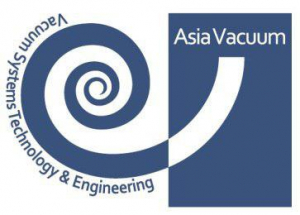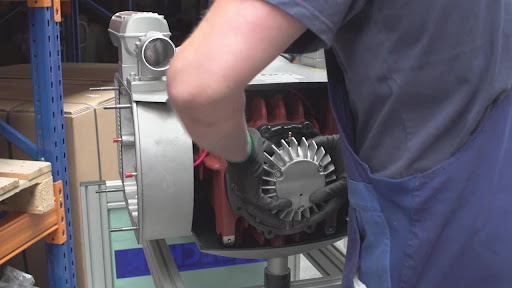Vacuum Systems
Presentation on theme: “Modern Devices: Chapter 4 – Vacuum Systems”— Presentation transcript:
1 Modern Devices: Chapter 4 – Vacuum Systems
Modern Devices: The Simple Physics of Sophisticated TechnologyCopyright © John Wiley and Sons, Inc.Chapter 4 – Vacuum SystemsEnabling High-Tech IndustriesModern Devices:The Simple Physics of Sophisticated TechnologybyCharles L. Joseph and Santiago Bernal
2 Vacuum Chamber Technology
Modern Devices: The Simple Physics of Sophisticated TechnologyCopyright © John Wiley and Sons, Inc.Fig. 4.1 A large floor-standing vacuum chamber. At the left is an ion vacuum gauge (top) and valve with rubber hose to roughing pump (bottom). Numerous access ports (electrical feedthroughs, window ports, and blanks) are shown on the circumference. A cryopump is shown attached underneath chamber.Vacuum technology is needed for a wide variety of advanced instrumentation and manufacturing methods. Creating a vacuum is simply a matter of pumping the gasses out of a sealed container, known as a chamber or tank. Ultimately, the achievable level of vacuum is set by the pumping speed compared to the residual leak rate.Vacuum chambers come in all shapes and sizes. Most have various ports to feedthrough electrical signals or to manipulate mechanically items inside the chamber.Vacuum Chamber Technology
3 Operating ranges of pumps and gauges
Modern Devices: The Simple Physics of Sophisticated TechnologyCopyright © John Wiley and Sons, Inc.Figure 4.2 The normal operating ranges of various type of pumps (red) and gauges (blue). The three classifications of vacuum are shown at the top.Operating ranges of pumps and gaugesUHVHigh Vac.Rough VacuumVenturi PumpMechanical PumpSorption PumpThermocouple GaugeDiffusion PumpTurbomolecularCryopumpIon PumpUHV Ion Gauge (hot filament)Pressure (Torr)
4 Vacuum Chamber Technology
Modern Devices: The Simple Physics of Sophisticated TechnologyCopyright © John Wiley and Sons, Inc.Fig. 4.3 Cross-sectional diagrams of the two type of vacuum sealing mechanisms. The sealing surfaces as depicted are on the top and bottom surfaces. The groove must be wide enough to allow the O-ring to deform, making a seal. For a gasket, the harder knife-edge flange cuts a sealing grove into the softer gasket material.Hallow tube to establish a sealed volume between vacuum componentsASA-style sealTop and bottom O-ring vacuum sealing pointsConflat SealSeal by cutting intocopper gasketThere are two basic types of seals used for connecting two vacuum tank pieces together: 1) rubber or Viton O-rings pinched between two metal surfaces and 2) copper or silver-plated copper gaskets sandwiched between two surfaces with hard knife edges. Ultrahigh vacuums (UHV) can only be achieved with metal gasket seals. UHV chambers that do have O-rings, those portions are isolated from the main chamber via a UHV valve.Vacuum Chamber Technology
5 Vacuum Chamber Technology
Modern Devices: The Simple Physics of Sophisticated TechnologyCopyright © John Wiley and Sons, Inc.Figure 4.4 An assortment of O-rings and copper gaskets along with a flanges. One feedthrough flange with three electrical connectors is shown at top center.Vacuum Chamber TechnologyThere are several standard configurations for O-rings and gaskets, as well as a number of vacuum quick-connection flange systems. For simplicity, the ASA O-ring and the CF Conflat gasket systems are shown in several sizes.O-rings can be reused many times, but copper gaskets are generally used only once. Copper gaskets, however, remain excellent seals for years if undisturbed.
6 Physics of some vacuum gauges
Modern Devices: The Simple Physics of Sophisticated TechnologyCopyright © John Wiley and Sons, Inc.Thermocouple JunctionHeatedFilamentHallow Pipe toVacuum ChamberElectricalContactsi2 i1Physics of some vacuum gaugesThe physics behind a TC can be understood in terms of the responses of various metal alloys to temperature. When two ends of a wire are held at two different temperatures, a small voltage potential of a few millivolt (mV) is observed between the two ends. If two wires of different alloys are subjected to the same temperature disparity, one will have a slightly higher voltage than the other. A thermocouple junction is created if the two ends are connected together and share a common DT.This device is transformed into a vacuum pressure measurement by continually adding a fixed amount of heat via the filament. The amount of residual gas in the chamber impacts the amount of convective cooling and in turn, determines the equilibrium temperature at the TC junction end. The net current flowing through the TC measures the pressure.A thermocouple (TC) gauge is perhaps the most widely used since its operating range starts at the limits of mechanical vacuum gauges and ends at the crossover pressures for starting most HV or UHV pumps.Figure 4.5 The anatomy of a thermocouple (TC) gauge. The interior volume of the gauge has the same vacuum as the chamber, usually being connected through a hallow pipe (right) with a threaded end. The resistance of the TC is set by rate of cooling, which is proportional to the amount of residual gas.
7 Physics of some vacuum gauges
Modern Devices: The Simple Physics of Sophisticated TechnologyCopyright © John Wiley and Sons, Inc.Ion collectorThermionicEmissionFilamentHallow metaltube to vacuumGlassTubeGridFigure 4.6 A hot cathode ion gage functions by passing a current and resulting voltage drop through a resistive material that heats up, emitting electrons into the vacuum. A series of rings connected to the positive volt side of the DC voltage, accelerating the free electrons towards the center. While these rings collect some electrons, many pass through, ionizing the residual gas. The current between the ion collector and the grid is proportional to the residual pressure.Physics of some vacuum gaugesThe UHV sensor of choice is the hot cathode ion gauge. The voltage across the resistive hot filament is typically 30 Vdc and generates a 10 mA (0.01 Amps) current of thermionic free electrons. These free electrons are attracted towards the grid, which biased at approximately +150 to +200 Vdc.While hot cathode ionization gauges have linear response over 10-4 to torr, all ion-gauge measurements are seriously affected by gas composition. For example, He gas only produces of the signal that N2 gas does,
8 via venturi, mechanical, or sorption pumps
Modern Devices: The Simple Physics of Sophisticated TechnologyCopyright © John Wiley and Sons, Inc.mufflerFigure 4.7 In a venturi pump, a gas flows through a restriction, causing the pressure to drop. An opening (bottom) pulls air from the volume to be evacuated. Only low-quality, rough vacuums can be established with this device.Low vacuumvia venturi, mechanical, or sorption pumps
9 via venturi, mechanical, or sorption pumps
Modern Devices: The Simple Physics of Sophisticated TechnologyCopyright © John Wiley and Sons, Inc.Right Sorption Pump without Styrofoam sleeveLeft Sorption PumpStyrofoam sleeve tohold liquid nitrogenValveVenturiPumpThermocouple& gaugeMetalHoseFigure 4.8 A pair of sorption pumps along with supporting equipment is shown. These pumps function by cooling the residual gas from the chamber to the point where it condenses to liquid form. The pictured pump station has valves so one or both sorption pumps can be used and gauges to measure two stages of vacuum.Low vacuumvia venturi, mechanical, or sorption pumpsPumps are classified into two types: gas transfer and gas capture. A sorption pump is a gas capture type. It pulls a vacuum by trapping and condensing most gases into the liquid phase. Eventually, gas capture pumps become full, must be taken off line, and heated to drive out the captured gas.
10 via diffusion, turbomolecular, or cryogenic pumps
Modern Devices: The Simple Physics of Sophisticated TechnologyCopyright © John Wiley and Sons, Inc.Oil reservoirTo roughingPumpSeparateLN2 TrapVacuum ChamberExteriorflow ofcoolingwaterHeating elementFigure 4.9 A schematic representation of a molecular diffusion pump is shown. A heating element causes a special oil of large, complex molecules to boil, sending small amounts of oil upward as depicted by the gray arrows. The oil strikes deflectors and is gravitationally pulled back towards the oil reservoir, dragging residual gas molecules down to the lower portion of the pump. A roughing pump continuously removes the slightly over-pressurized gas caused by the oil flow.High Vacuum (HV)via diffusion, turbomolecular, or cryogenic pumpsIn contrast to the gas-capture sorption pump, the molecular diffusion pump is a gas transfer type. A foreline pump must first be used to achieve a vacuum at or below the crossover point. Then the chamber can be opened to the diffusion pump, but the foreline pump must be used a second time to remove the transferred exhaust from this main pump.
11 via diffusion, turbomolecular, or cryogenic pumps
Modern Devices: The Simple Physics of Sophisticated TechnologyCopyright © John Wiley and Sons, Inc.Venturi 8K He15 K cold vanes to trap N2, O2CompressorPressurizedHe gas inputHe gas return80K cold head to trap H2OReflective, 80K ShieldFigure 4.10 A cryogenic pump operates by dramatically changing the pressure of He gas at two points in the cycle. The sudden drop in the He pressure causes it to go from approximately room temperature to about 10 degrees above absolute zero. The helium is connected to a series of vanes, which become sufficiently cold to freeze the residual gas from the vacuum chamber.High Vacuum (HV)via diffusion, turbomolecular, or cryogenic pumpsA Cryopump is an oil-free high-vacuum pump of the gas capture type. Cryopumps, properly known as cryogenic pumps, are similar to sorption (cryosorption) pumps, except portions of the pump are substantially colder. The basic physics behind the cryopump is to create an ultimate refrigerator and attach a cold finger to a series of progressively larger cold surfaces. The primary requisite is to get various surfaces sufficiently cold that various gas constituents are frozen or adsorbed onto one of several surfaces and held there for extended periods. It normally takes about 2 hours before a cryopump gets down to operating temperatures. These pumps require extensive roughing to vacuum pressures of ~50 microns (~5 x 10-2 torr) on the pump itself prior to turning on the compressor.
12 Ultrahigh Vacuum (UHV)
Modern Devices: The Simple Physics of Sophisticated TechnologyCopyright © John Wiley and Sons, Inc.Figure 4.11 Ion pumps produce strong internal electrical fields, which accelerate the electrons and positively charged molecules. Many of these charges strike titanium or titanium and tantalum plates releasing a few Ti or Ta atoms, which chemically bond with gas molecules and then become adsorbed onto the interior walls of the pump in a process known as gettering. The sequence of events also produces more ions, which continue the pumping process.Ultrahigh Vacuum (UHV)via ion pumpsIon pumps are the best choice for UHV chambers, since these pull the hardest vacuums, as well as are clean, vibration free, and can be baked. Ion pumps also have low power consumption and long operating lifetimes despite being a gas capture type pump.



